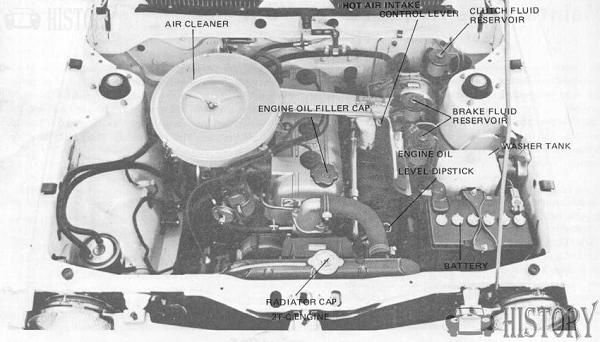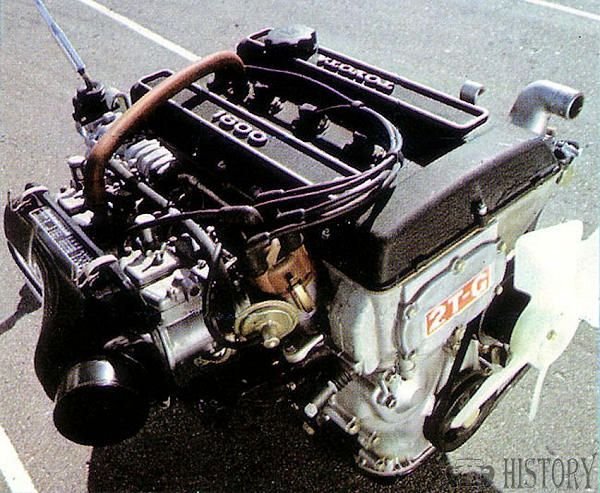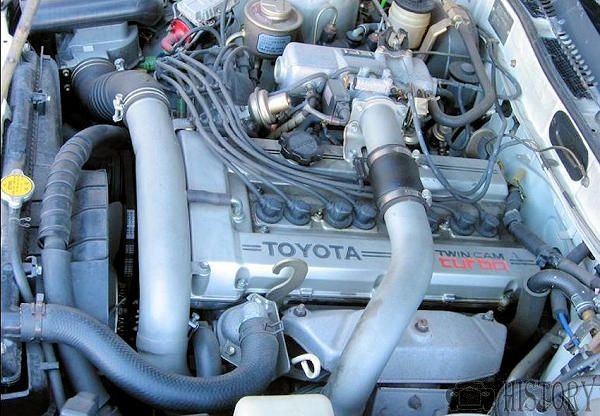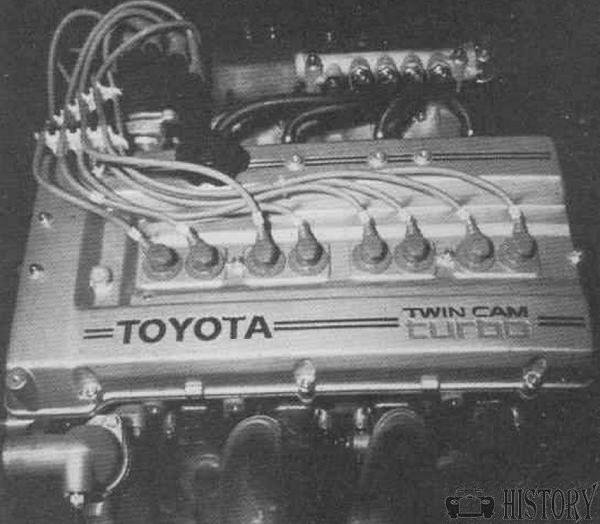Toyota T engine
| 1970 to 1985 | |
|---|---|
 | |
| Overview | |
| Manufacturer | Toyota |
| Production | 1970-1985 |
| Combustion chamber | |
| Cylinder block alloy | Cast iron |
| Valvetrain | 8 valve chain-driven |
| Fuel | Petrol |
The Toyota T series is a family of inline-4 automobile engines manufactured by Toyota beginning in 1970 and ending in 1985. It started as a pushrod overhead valve (OHV) design and later performance oriented twin cam (DOHC) variants were added to the lineup. Toyota had built its solid reputation on the reliability of these engines.
The 4T-GTE variant of this engine allowed Toyota to compete in the World Rally Championship in the early 1980s, making it the first Japanese manufacturer to do so.
Race engines based on the 2T-G include the 100E and 151E.
- All T engines utilize a timing chain and have a cast iron block with an alloy cylinder head with hardened valve seats and a hemispherical combustion chamber design (HEMI)..
- All T engines are carburated except those with electronic fuel injection, "E" designation.
- All T engines use a 2 valve OHV design except those with a DOHC performance head, "G" designation.
- The 12T/13T has a sub-cylinder directly behind the spark plug that leads into a smaller chamber for emission purposes.
Features overview
| Code | Bore mm | Stroke mm | Power PS (kW) | Torque lb·ft (N·m) | Compression | Years | Comments |
|---|---|---|---|---|---|---|---|
| T | 80 | 70 | 86 at 6,000 rpm | 86 at 3,800 rpm | 8.5 | 1970–1979 | |
| T-B | 80 | 70 | 95 at 6,000 rpm | 89 at 4,000 rpm | 9.0 | 1970–1975 | dual carburetor |
| T-BR | 80 | 70 | 91 at 6,000 rpm | 86 at 4,000 rpm | 8.5 | 1970–1975 | dual carburetor, low compression |
| T-J | 80 | 70 | 80 at 6,000 rpm | 82 at 3,800 rpm | 8.5 | 1975-1979 | Japanese emission controls for commercial vehicles |
| 2T | 85 | 70 | 102 (76) at 6,000 rpm | 101 at 3,800 rpm | 8.5 | 50 kW and 105Nm (South Africa) | |
| 2T-C | 85 | 70 | 88 at 6,000 rpm | 91 at 3,800 rpm | 8.5 | 1970–1979 | emission controls (EGR) |
| 2T-B | 85 | 70 | 105 at 6,000 rpm | 101 at 4,000 rpm | 9.4 | 1970–1975 | dual carburetor |
| 2T-BR | 85 | 70 | 100 at 6,000 rpm | 100 at 4,000 rpm | 8.5 | 1970–1975 | dual carburetor, low compression |
| 2T-U | 85 | 70 | 90 at 6,000 rpm | 94 at 3,800 rpm | 8.5 | 1975– | Japanese emission controls (TTC-C) |
| 12T | 85 | 70 | 90 at 6,000 rpm | 94 at 3,800 rpm | 9.0 | Japanese emission controls (TTC-L) | |
| 12T-U | 85 | 70 | 88 at 5,600 rpm | 96 at 3,400 rpm | 9.3 | Japanese emission controls (TTC-V) | |
| 12T-J | 85 | 70 | Japanese emission controls for commercial vehicles | ||||
| 2T-G | 85 | 70 | 115 at 6,400 rpm | 105 at 5,200 rpm | 9.8 | 1970–1975 | DOHC, dual carburetor |
| 2T-GR | 85 | 70 | 110 at 6,000 rpm | 101 at 4,800 rpm | 8.8 | 1970–1975 | DOHC, dual carburetor, low compression |
| 2T-GEU | 85 | 70 | 115 at 6,000 rpm | 109 at 4,800 rpm | 8.4 | 1978–1985 | DOHC, EFI, Japanese emission controls (TTC-C) |
| 3T | 85 | 78 | |||||
| 3T-C | 85 | 78 | emission controls (EGR) | ||||
| 3T-U | 85 | 78 | Japanese emission controls (TTC-C) | ||||
| 3T-EU | 85 | 78 | 105 at 5,400 rpm | 162 at 3,600 rpm | 9.0 | EFI, Japanese emission controls (TTC-C) | |
| 3T-GTE | 85 | 78 | 160 at 6,000 rpm | 152 at 4,800 rpm | 7.8 | DOHC, EFI, turbo, twin spark plugs, Japanese emission controls | |
| 3T-GTEU | 85 | 78 | Same as 3T-GTE | ||||
| 13T | 85 | 78 | Japanese emission controls (TTC-L) | ||||
| 13T-U | 85 | 78 | Japanese emission controls (TTC-V) | ||||
| 4T-GTEU | 85.5 | 78.0 | 180 | Road version, DOHC, EFI, turbo, twin spark plugs, Japanese emission controls, 1,791 cc | |||
| 4T-GTEU | 89.0 | 84.0 | 180 | Race version, DOHC, EFI, KKK turbo, twin spark plugs, 2,090 cc |
T
The first T engine displaced 1,407 cc and was produced from 1970 through 1979. Cylinder bore is 80 mm (3.15 in) and stroke is 70 mm (2.76 in).
Output is 86 hp (64 kW) at 6,000 rpm and 85 lb·ft (115 N·m) at 3,800 rpm. The more-powerful (95 PS) twin-carburetor T-B was produced for the first six years, as well as the single carb T-D which had a somewhat higher compression ratio for 90 PS (66 kW).
From 1977 there was also a T-J, a version with some simple emissions equipment intended for Japanese market commercial vehicles. With an 8.5:1 compression ratio, this produces 80 PS (59 kW) at 6,000 rpm and 11.3 kg·m (111 N·m; 82 lb·ft) at 3,800 rpm.
The T-U also appeared in 1977 with even stricter emission equipment for Japanese market non-commercial vehicles.
Applications:
- 1970–1977 Toyota Carina TA10/15/16V (first generation)
- 1977–1979 Toyota Carina Van TA16V (second generation, T-J)
- Toyota Celica TA20
- Toyota Corolla TE20/25
- Toyota Corolla TE30/35/50
- Toyota Sprinter TE40/50
2T
The larger 1,588 cc 2T was produced from 1970 through 1984. Cylinder bore is 85 mm and stroke is 70 mm.
The 2T engines are usually coupled with either a T40 4 speed/T50 5 speed manual transmission, or an A40 3 speed automatic transmission.
Output for the early 2T-C bigport design is 102 hp which is also due to different SAE testing methods, while the later version is 75 hp (56 kW) at 5200 rpm and 86 lb·ft (116 Nm) at 3800 rpm, compression at 9.0:1. The twin-carb 2T-B produces 90-105 hp (67-78 kW) and 85–102 lb·ft (115-138 N·m). The 2T-J, for commercial vehicles with less restrictive emissions standards, produces 93 PS (68 kW) at 6000 rpm and 13.1 kg·m (128 N·m; 95 lb·ft) at 3800 rpm.
Applications:
- Toyota Corolla E20 through E30 series
- Toyota Carina A10 through A60 series
- Toyota Celica A20 through A60 series
- Toyota Corona TT100/106V/110
- Toyota Corona TT130/137V
- Toyota Corona TT140
- Daihatsu Charmant
- Toyota TownAce TR10V (2T-J)
- Daihatsu Delta Wide TB10
This engine was also commonly used in Australian Formula Two race cars during the 1970s and 1980s, where they typically made between 180 and 200 hp. The 1979 championship was won by a Toyota 2T powered Cheetah mk6. In 1984 Peter Glover borrowed a Cheetah mk7 powered by Toyota 2T for one round. The car won the round and helped secure the championship.
12T
The 1,588 cc 12T and 12T-U (lean burn) was produced from 1970 through 1983. It produces 88 hp (66 kW) at 5,600 rpm and 96 lb·ft (130 N·m) at 3,400 rpm. There was also a 12T-J version for commercial vehicles, which didn't have to meet as stringent emissions standards in Japan. In response to Honda's CVCC emissions, Toyota introduced "TTC-L", using a lean burn implementation.
Applications:
- Toyota Corolla TE52
- Toyota Corolla Van TE73/74 (12T-J)
- Mar 1976-Jul 1977 Toyota Carina TA31-A
- Aug 1977-Aug 1981 Toyota Carina TA41-A
- Aug 1979-Aug 1981 Toyota Carina Van TA49V-A (12T-J)
- Aug 1977-Jun 1981 Toyota Celica TA41-B
- Jan 1980-Feb 1982 Toyota Celica Camry TA41-C
- Toyota Corona TT120
- Sep 1978-Dec 1981 Toyota Corona TT130
- Dec 1979-Dec 1981 Toyota Corona Van TT138 (12T-J)
- Jan 1982-Oct 1983 Toyota Corona Van TT147 (12T-J)
- Toyota Sprinter TE66
- Toyota TownAce Wagon TR11G
- Apr 1978-Sep 1981 Daihatsu Charmant A40
- Daihatsu Delta Wide Wagon TB11G

2T-G
The 2T-G, produced from 1970 through 1983, is a chain driven 8v DOHC version. Output is 110-125 hp (82-93 kW) and 105–109 lb·ft (142-147 N·m). Variants include the air-injected 2T-GR, Japan-spec 2T-GU, and fuel injected 2T-GEU. Twin sidedraft 40mm mikuni-solex PHH carburetors were used in non EFI versions. All 2T-G cylinder heads were cast by Yamaha, however, some are not marked as such.
The 2T-G was replaced by the 4A-GE in most applications.
Applications:
- Toyota Corolla Levin/Sprinter Trueno E20 through E70 series
- Toyota Celica A20 through A60 series
- Toyota Carina A10 through A60 series
Like the 2.0 L 18R-G, the 2T-G was considered the flagship engine of Toyota's 1600 class until it was superseded by the 4A-GE in the 1980s. The 2T-G is still a popular engine for conversions to classic Celicas and Corollas and are often suitable for classic and formula racing series.
When bored out to a maximum of 89 mm and combined with a 3T crankshaft, the 2T and 2T-G will have a displacement of almost 2.0L. The 2T and 3T series use the same connecting rod dimensions, with the different pin heights on the pistons. Aftermarket pistons are available from very low (<7:1) through to very high (>13:1) compression ratios. Racing 2T-G engines ("NOVA") featured 87.0 mm bore and 84.0 mm stroke for a 1,997 cc displacement. Output is around 170 PS (125 kW) at 6,000 rpm with a 12:1 compression ratio. This engine was used in Formula 3 cars in both Europe and Japan (where it dominated), as well as in Formula Pacific (FP).
3T
The 3T displaces 1770 cc and was produced from 1977 through 1985. Cylinder bore is 85 mm (3.35 in) and stroke is 78 mm (3.07 in). Originally compliant with Japan's 1976 emissions standards (TTC-C), from October 1977 it used Toyota's lean burn system called TGP ("Turbulence Generating Pot") in order to pass the 1978 emissions standards.
The 3T OHV engines are mated to either of a T40 4-speed, T50 5-speed manual transmission, or an A40 3-speed, or A40D 4-speed automatic transmission.
Output ranges from 70-105 hp (52-78 kW) and 93–120 lb·ft (126-162 N·m) between the California 3T-C and Japan-spec fuel injected 3T-EU.
Applications:
- Toyota Carina TA40 series
- Toyota Corolla TE72
- Toyota Corona TT130 series
- Toyota Corona TT141
- Toyota Celica A60 series
- Toyota Celica Camry TA50 series
- Toyota Mark II/Chaser TX30 series
13T
The 1,770 cc 13T-U was produced from 1977 through 1982. It produces 95 PS (70 kW) at 5,400 rpm and 15.0 kg·m (147 N·m) at 3,400 rpm with a twin barrel carburettor.
Applications:
- August 1979–1982 Toyota Corolla TE70
- Toyota Celica A40 series
- Toyota Celica Camry TA46
- Toyota TownAce TR15
- Toyota TownAce Truck TM20
- Toyota Cresta TX50
- Toyota Chaser and Toyota Mark II TX60
- Daihatsu Delta Wide Wagon TB15G (TownAce)

3T-GTE
The 3T-GTE, first released in September 1982, is the most performance orientated version of the 1,770cc 3T engine. It features a hemi chambered 8v twin-cam head with twin-spark (two spark plugs per cylinder) design and swirl inlet ports for better efficiency. The EFI system saw the introduction of knock control. It is turbocharged by a Toyota CT20 Turbo (the same unit as used in the 2L-T diesel) to generate 160 PS (119 kW) at 6,000 rpm and 152 lb·ft (206 N·m) at 4,800 rpm. This was the first turbocharged twin-cam engine built in Japan. Units built after May 1983 received a water cooled turbocharger. The engine was considerably over-engineered for durability, for instance featuring doubled cam roller chains, as it was also to form the basis for the 4T-GT competition engines.It either came mated to a W55 5speed manual with a larger 225mm clutch and lighter 8kg flywheel or an A43D 4speed automatic transmission.
Applications:
- Sept 1982–-1985 Toyota Celica TA63
- Sept 1982–-? Toyota Carina TA63
- Sept 1982–-? Toyota Corona TT142
3T-GTE powered vehicles are badged as GT-T or GT-TR.

4T-GTE
This is the version of the T family which powered Toyota's Group B and World Rally Championship cars. The homologation engine, introduced in November 1982, features a 0.5 mm increase in bore over the 3T, giving 1,791 cc. With a multiplication factor of 1.4 for turbocharged engines, this equalled 2,507 cc in the eyes of the FIA, placing the Celica in the 2,501-3,000 cc class. The smaller 3T engine would have fit snugly under the 2.5-liter limit, but being in the larger class allowed Toyota to stretch the 4T-GT engine to 2,090 cc (89.0 x 84.0 mm for a converted displacement of 2,926 cc) which better suited the comparatively heavy Celica.
In race trim it was a high-performance engine of 2,090 cc with either a Toyota or a KKK/K27 turbocharger, electronic fuel injection, and a twin-spark ignition system, producing 360 to 600 PS depending on race trim. The 1984 Group B rally version produced 326 PS (240 kW) at 8,000 rpm. The road going homologation version (4T-GTEU, 200 built) produces 180 PS (132 kW). The total build number, including modified versions, was 228.
Applications:
- Toyota Celica Twincam Turbo TA64 GT-TS
- Toyota Celica "IMSA GTO"
- Toyota 83C
- Toyota 84C
- Toyota 85C
- Toyota 86C
- Eagle Mk I
Race engines
The '151E' engine used 4 valves per cylinder.
The '100E' engine used twin spark plugs with 2 valves per cylinder but was used mainly by a Toyota works team.
Italy Nova Corporation produced a 2.0 L engine based on the 2T-G that was used in most of the world F3 cars for a long time.
The production 1791 cc 4T-GTE was stretched to 2090 cc for race use.
Technical
-
Toyota T engine Technical details and specifications (1970-1985)
Toyota 1.6L Engine code: 2T
No. of cylinders 4/OHV
Capacity 1588 cc
Firing order 1-3-4-2
Compression ratio 8.5:1
Suitable for unleaded petrol yes
Fuel system Carb-2V
Ignition coil Make Denso 02022/02037
Distributor Make Denso 19100/25030
Starter motor Make Denso 26020/26080
Distributor Contact breaker gap 0.4-0.5 mm
Oil pressure 3.5-4.5 bar @ 2000 rpm
Thermostat opens 82°C
Maximum cranking amps 108-132A
Regulated voltage 13.8-14.4V© Motor car History


